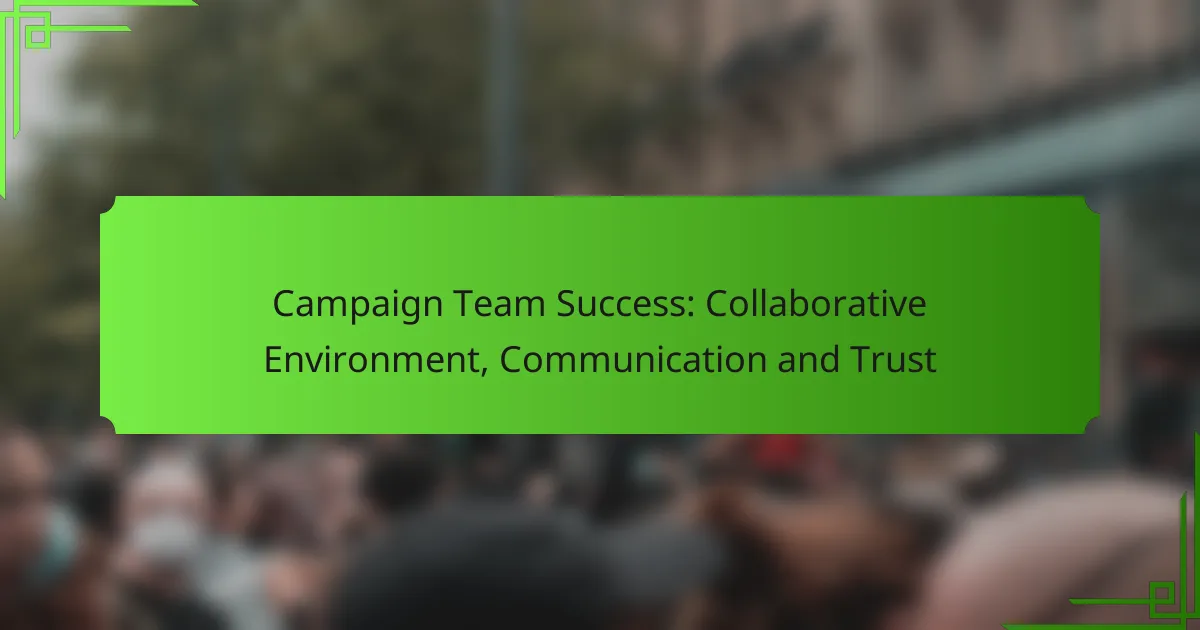A successful campaign team thrives in a collaborative environment that prioritizes open communication and trust. By fostering these elements, teams can align their goals and enhance engagement, ultimately leading to improved campaign performance. Effective communication strategies further strengthen this dynamic, ensuring that all members remain informed and connected throughout the campaign process.

How can a collaborative environment enhance campaign team success?
A collaborative environment significantly boosts campaign team success by fostering open communication, trust, and shared goals. This synergy leads to improved outcomes and a more engaged team, ultimately driving better campaign performance.
Increased creativity and innovation
A collaborative environment encourages team members to share diverse ideas and perspectives, which can spark creativity and innovation. When individuals feel safe to express their thoughts, they are more likely to propose unique solutions that can differentiate a campaign.
To cultivate this creativity, hold regular brainstorming sessions where all team members can contribute. Consider using tools like digital whiteboards to visualize ideas and encourage participation from everyone, regardless of their role.
Improved problem-solving capabilities
Collaboration enhances problem-solving by bringing together varied expertise and viewpoints. When team members work together, they can analyze challenges from multiple angles, leading to more effective solutions.
Encourage a culture of collective problem-solving by establishing small groups to tackle specific issues. This approach not only leverages the strengths of different team members but also promotes accountability and ownership of the solutions developed.
Stronger team cohesion
A collaborative environment fosters stronger team cohesion as members build relationships based on trust and mutual respect. When individuals collaborate, they develop a sense of belonging and commitment to the team’s objectives.
To strengthen cohesion, organize team-building activities that encourage interaction outside of work tasks. Simple exercises, such as group lunches or team challenges, can enhance interpersonal connections and improve overall team dynamics.
Enhanced employee satisfaction
When team members feel valued and included in a collaborative environment, their job satisfaction tends to increase. Higher satisfaction levels often lead to improved morale and reduced turnover rates, benefiting the campaign’s continuity and effectiveness.
To enhance employee satisfaction, regularly solicit feedback on team processes and make adjustments based on input. Recognizing individual contributions and celebrating team successes can further boost morale and create a positive work atmosphere.

What communication strategies improve campaign team effectiveness?
Effective communication strategies enhance collaboration and trust within campaign teams. By implementing structured approaches, teams can ensure that everyone stays informed, aligned, and engaged throughout the campaign process.
Regular team check-ins
Regular team check-ins are essential for maintaining alignment and addressing any issues promptly. These meetings can be held weekly or bi-weekly, allowing team members to share updates, discuss challenges, and celebrate successes.
During check-ins, it’s beneficial to establish a clear agenda to keep discussions focused. This can include project milestones, individual responsibilities, and any roadblocks that need resolution. Consider using a rotating facilitator to encourage participation and ownership among team members.
Utilization of project management tools like Asana
Project management tools like Asana streamline communication and task management within campaign teams. These platforms allow team members to assign tasks, set deadlines, and track progress in real-time, ensuring everyone is on the same page.
When using tools like Asana, it’s important to customize the workflow to fit the specific needs of the campaign. Create clear project timelines and use tags or labels to categorize tasks by priority or team member. This helps in visualizing the project’s status and identifying areas that may require additional attention.
Clear and open feedback channels
Establishing clear and open feedback channels fosters a culture of trust and continuous improvement within campaign teams. Encourage team members to share their thoughts and suggestions openly, whether through regular feedback sessions or anonymous surveys.
To ensure feedback is constructive, set guidelines on how to give and receive it. Focus on specific behaviors or outcomes rather than personal attributes. This approach not only enhances communication but also empowers team members to take ownership of their contributions to the campaign.

How does trust impact campaign team dynamics?
Trust significantly enhances campaign team dynamics by fostering open communication and collaboration. When team members trust each other, they are more likely to share ideas, take risks, and support one another, leading to a more effective and cohesive team environment.
Fosters a safe environment for sharing ideas
A trusting atmosphere encourages team members to express their thoughts without fear of judgment. This openness can lead to innovative solutions and creative strategies that might not surface in a less supportive environment.
To cultivate this safe space, leaders should actively promote inclusivity and respect diverse viewpoints. Regular brainstorming sessions can help reinforce this culture by allowing everyone to contribute equally.
Encourages accountability among team members
Trust among team members promotes a sense of accountability, as individuals feel responsible for their contributions and the overall success of the campaign. When team members trust each other, they are more likely to follow through on commitments and support one another in achieving shared goals.
To enhance accountability, establish clear roles and expectations from the outset. Regular check-ins can help ensure that everyone remains aligned and responsible for their tasks.
Strengthens relationships and collaboration
Trust is foundational for building strong relationships within a campaign team, which in turn enhances collaboration. When team members feel connected and valued, they are more likely to work together effectively, leveraging each other’s strengths to achieve common objectives.
Encouraging team-building activities and social interactions can help strengthen these relationships. Simple practices like celebrating small wins together can foster a sense of unity and shared purpose, further enhancing collaboration.

What are the key components of a successful campaign team?
A successful campaign team relies on defined roles, shared goals, and diverse skill sets. These components foster collaboration, enhance communication, and build trust among team members, ultimately driving the campaign’s effectiveness.
Defined roles and responsibilities
Clearly defined roles and responsibilities are essential for a successful campaign team. Each member should understand their specific tasks and how they contribute to the overall objectives. This clarity helps prevent overlap and confusion, allowing team members to focus on their strengths.
To establish defined roles, consider creating a responsibility matrix that outlines who is accountable for each task. Regular check-ins can also help ensure everyone is aligned and aware of their contributions.
Shared goals and objectives
Shared goals and objectives unify the team and provide a clear direction for the campaign. When all members are working towards the same targets, it enhances motivation and accountability. Setting SMART (Specific, Measurable, Achievable, Relevant, Time-bound) goals can be particularly effective.
Regularly revisiting these goals during team meetings helps maintain focus and allows for adjustments based on progress. Celebrating milestones along the way can also strengthen team cohesion and commitment.
Diverse skill sets and perspectives
A successful campaign team benefits from diverse skill sets and perspectives. This diversity fosters creativity and innovation, enabling the team to approach challenges from various angles. Incorporating members with different backgrounds can lead to more comprehensive strategies and solutions.
Encourage open dialogue and brainstorming sessions to leverage these diverse perspectives. Additionally, consider conducting skills assessments to identify gaps and ensure that all necessary competencies are represented within the team.

How can teams measure their collaborative success?
Teams can measure their collaborative success through various metrics that reflect their communication, trust, and overall performance. Key indicators include team performance metrics, feedback mechanisms, and project outcomes, which provide insights into how well team members work together.
Team performance metrics
Team performance metrics are quantifiable measures that help assess how effectively a team collaborates. Common metrics include the completion rate of tasks, adherence to deadlines, and the quality of work produced. These indicators can highlight areas where collaboration is strong or where improvements are needed.
For example, a team that consistently meets deadlines may indicate effective communication and trust among members. Conversely, a high number of missed deadlines could suggest issues in coordination or resource allocation. Tracking these metrics over time can reveal trends that inform team strategies.
To effectively use performance metrics, teams should establish clear benchmarks and regularly review their progress. Consider using a simple scorecard that includes metrics like task completion rates, peer feedback scores, and project success rates to facilitate ongoing assessment and adjustment.
